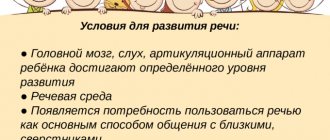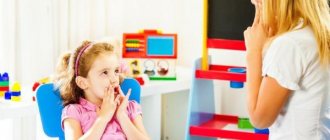A child who goes to 1st grade must be able to read and write. If there are any developmental deviations, it will be difficult for him to learn the material in class, and his performance will decline. To avoid this, you need to work with your baby from birth.
There is a certain sequence of sounds. If this is neglected, then various disturbances in the pronunciation of sounds will arise, which are considered in speech therapy from the point of view of the disease (sometimes they can be corrected).
Types of disorders of the pronunciation aspect of speech in speech therapy
Even a temporary delay in speech development can adversely affect the child’s overall development. Mastering correct speech is a necessary condition for mastering literacy and studying at school. In speech therapy, certain types of disorders are distinguished, which include alalia, dyslalia and dazarthria.
Alalia
Alalia is a complex disorder of speech development. It denotes the immaturity of all parts of speech as a result of the fact that the speech zones in the cerebral cortex were affected before birth and from 0 to 3 years.
In turn, alalia is divided into:
- motor;
- sensory.
It happens that a child has a mixed form of the disease, but one type is predominant. Motor (expressive) alalia can be corrected, while a child with sensory (impressive) alalia has physical hearing but does not understand what others say.
Dislalia
Dyslalia refers to disturbances in the pronunciation of sounds, but the child has good hearing and a normally developed articulatory apparatus. A child with this diagnosis misses, replaces, mixes or distorts sounds when pronouncing them. In speech therapy, dyslalia is considered a common disease.
Approximately 25-30% (sometimes 50%) of preschool-age children and 18-20% of primary school-age children are diagnosed with this speech disorder. If it is not corrected in time, in the future the child will not be able to fully master writing, and disorders such as dysgraphia and dyslexia may develop.
Dysarthria
With dysarthria, the central part of the analyzer (speech motor) is affected and the functioning of the muscles of the speech apparatus is disrupted. The child’s speech motor skills, sound pronunciation, and speech breathing suffer, so speech is inarticulate and slurred. If dysarthria is diagnosed, then a speech therapist, neurologist, or psychiatrist works with the baby.
Pronunciation of the th sound in English
Yes, we don't have these sounds. But we have the concept of “lisp.” Do you remember Sid the sloth from Ice Age: “No, I f
Is
anyone
young
enough
to die!” In the English dictionary, the word “lisp” (lisp) is interpreted as “a speech defect in which s and z sound like th in think and this, respectively.”
This video talks about lisps. I recommend watching: simple and humorous.
That is, it turns out that we need to pronounce Russian / s / with a lisp for the deaf / θ / and Russian / z / for the voiced / ð /. What do you mean, “lisp”? Say the word “composition” right now. When pronouncing the /c/ sound, your tongue is BEHIND your teeth. Now place your tongue between your teeth (the th sound is interdental) and say “composition” again. You will end up with something like a deaf th, as in the word thick.
Now do the same, but with the word “gap”. As a result, you will get something similar to a voiced th, as in the word then.
Why do I say “similarity”? Because Russian /s – z/ are not identical to English /s – z/, which means their lisp will be slightly different. Therefore, let’s take a closer look at the position of the articulatory apparatus.
Causes of speech disorders in children
A child’s speech can be delayed at any stage of its development for a variety of reasons. Such children often have a poor vocabulary that is not appropriate for their age group. The development of phrasal speech is somewhat delayed, and defects in the pronunciation of sounds persist for a long time.
One of the reasons for such a temporary delay in speech development may be various diseases suffered by the child at an early age. Speech development is greatly influenced by gastrointestinal diseases, as a result of which the nutrition of the whole body and the cerebral cortex is disrupted.
Speech disorders can also be caused by:
- fetal infection;
- lack of fetal oxygen;
- Rhesus conflict;
- risk of miscarriage;
- toxicosis;
- chronic high or low blood pressure in a pregnant woman or other diseases of the cardiovascular system;
- fall of the expectant mother, resulting in injury to the fetus;
- bad habits of a pregnant woman (smoking, alcohol, drugs);
- complex labor (including transient, protracted) or childbirth that began ahead of schedule;
- if obstetric instruments were used during childbirth;
- intracranial birth injury in a newborn;
- received traumatic brain injury from birth in early childhood;
- jaundice in a newborn (nuclear);
- genetic predisposition (one of the parents has a history of a disease associated with speech impairment);
- a child under 3 years of age often suffered from acute respiratory viral infections, pneumonia, rickets and other diseases;
- the baby underwent surgery using general anesthesia;
- a preschooler grows up in unfavorable social conditions;
- the child is diagnosed with cerebral palsy;
- the tongue or upper lip has a short frenulum;
- malocclusion, abnormal structure of the dentition or palate;
- The child has not developed phonemic hearing.
Among the etiological factors, social reasons can also be identified. If adults speak hastily, tongue-tied, dialectally, then the child will imitate them.
When the child is not engaged, then the preschooler is left to his own devices: he does not hear correct speech, they do not communicate with him, as a result of which he withdraws into himself, speaks little and poorly. If a family alternately speaks two languages, this can lead to speech impairment (dyslalia).
First stage. Articulatory gymnastics for whistling sounds (s, s, z, z, z)
As a rule, in a child who does not speak the sound s or pronounces it incorrectly, the sound pronunciation of other whistling sounds is also impaired (whistle sounds include the sounds s, з, ц and the soft version of the sounds - сь, зь). One of the reasons for incorrect pronunciation of sounds is insufficient mobility of the organs of the articulatory apparatus. Therefore, for correct pronunciation, special “regular exercise” is needed - articulatory gymnastics. The complex of articulatory gymnastics combines exercises that prepare strictly defined movements of the articulatory apparatus and the positions of the tongue and lips necessary for a given group of sounds and produce the correct air stream. Therefore, I really do not recommend that mothers, fathers, grandmothers, and grandfathers come up with their own articulation gymnastics complexes from different books and from the Internet. After all, all articulation gymnastics complexes are by no means composed randomly! It is impossible to form movements that are opposite to each other at the same time, therefore, in the complex of articulatory gymnastics, all exercises complement each other and are aimed at one goal - one group of sounds! Articulation gymnastics should be performed daily without breaks. The most convenient time is before breakfast in the morning. Carrying out such gymnastics requires only 3-5 minutes of your time. Each time, articulatory gymnastics is carried out in a playful way - in the form of a fairy tale or story, accompanied by exercises. This is where your imagination is welcome - you can come up with any plot in which you include these exercises, and change the plot and characters in accordance with the interests of your baby!
Tips for performing articulatory gymnastics - it is important to know and perform:
• Usually 2-3 exercises are performed at a time. Each exercise is performed multiple times. • If you add a new exercise , then there is only one, and all other exercises should be already familiar to the child by this time. • If a child finds it difficult to do old familiar exercises , then a new exercise is not introduced, but the old ones are reinforced. But consolidation occurs in a new form for the child - in a new plot, with new characters. • Articulation gymnastics should be done while sitting in front of a mirror - you sit next to the child facing the mirror and show all the movements, the child can clearly see your face. • It is imperative to monitor the symmetry of the face when performing gymnastics movements (the child’s movements must be symmetrical to the left and right half of the face). This is clearly visible to the child in the mirror, and he can track whether he is performing the movement correctly. • During articulatory gymnastics, it is necessary to monitor the accuracy, smoothness of movements, give the child clear criteria for the correctness and incorrectness of performing the exercise, correct his mistakes, monitor the absence of unnecessary side movements, a good pace of gymnastics and the ability to move from one movement to another. If you simply carry out the exercises formally, then their implementation is useless or of little use! After all, articulation gymnastics is not called that for nothing. This is truly “gymnastics”, in which correct movements are important, and not just playing with the tongue! By analogy: if you just lazily twirl your arms, it will not be physical education or fitness and will not have a good result for your health! It’s the same in articulation gymnastics. What is important for the result is the quality of the movements, and not any movement in itself. • Articulation gymnastics exercises, if performed correctly and accurately, are not easy for most children. Therefore, do not scold your child under any circumstances, do not grieve that he does not succeed the first time. Everything needs to be learned! And there is one law of life - everything that is developed develops! Therefore, everything is still ahead of you! Praise your baby for what he is already doing - you can already make your tongue wide, your tongue has already begun to move quickly, etc.
The preparatory complex of articulatory gymnastics includes exercises necessary for pronouncing any sounds. It is with this preparatory complex that it is best to start practicing articulatory gymnastics in kindergarten or at home. The basic version of this complex, which you can start doing at home: • Smile and keep your lips in a smile. In this case, the front teeth are exposed and clearly visible. • Tube. Pulling the lips forward with a tube. With this movement, only the lips move! • Ring. Ring-shaped lips. • Alternation: smile – ring – tube. • Calm opening and closing of the mouth , lips in a smile. There should be no other unnecessary movements! • The tongue is wide. • The tongue is narrow. • Alternation: wide tongue – narrow tongue. • Lifting the tongue by the upper teeth. • Alternating upward and downward movements of the tongue. • Alternating movements of the tongue with the tip of the tongue down: move the tongue deeper into the mouth - bring it closer to the teeth.
If these movements are easy for the child, then you can immediately move on to the complex for whistling sounds. If there are difficulties, then you need to train the basic movements from the preparatory complex. If a child cannot do the exercise with alternating “smile - ring - tube”, then I highly recommend consulting with a speech therapist.
A set of articulation exercises for whistling sounds p. z, c (Developed by Fomicheva M.V.).
Helpful Tips:
- In each exercise, I give a description of the movements and typical mistakes (see “What to pay attention to”). After the description you will find videos of all exercises.
- First, do all these exercises yourself in front of the mirror, paying attention to all the nuances, master them, and then learn them with your children.
- Never scold a child for a mistake, just show them again the correct version of the exercise, focusing on the necessary nuance, describe to the child in words how to perform the movements, what to watch for. Children are completely calm about the “funny tongue’s mistakes” and are happy to “teach” him to do the movements correctly.
Exercise 1. Put the ball into the goal.
Our task: in this exercise the child will learn to direct a long, directed stream of air. Performing the exercise: Place two cubes on the table - these are gates. And next to the gate on the table in front of the child, place a cotton ball. The child stretches his lips forward with a tube, blows on the ball and tries to drive it into the gate made of cubes. What you need to pay attention to: • Do not puff out your cheeks! The baby can hold them with his hands to control himself. • The air stream should be long and without interruptions - one long exhalation.
Exercise 2. Punish the naughty tongue.
Our task: to teach the child to keep his tongue wide and relaxed. And continue to produce a directed air stream. Performing the exercise: The child, opening his mouth slightly, puts his tongue on his lower lip and, smacking his lips, says five-five-five. He then opens his mouth and keeps his tongue relaxed, wide and resting on his lower lip. I don’t like to “punish” the tongue with children, which is already trying its best to practice, so I do this exercise with the kids in a different plot - the tongue rests and sings the song five-five-five. Or I suggest the child massage his tongue: five-five-five. You can come up with your own plot. What you need to pay attention to: • The lower lip should not curl up. • The edges of the tongue touch the corners of the mouth - the tongue is really very wide. • We pat the tongue with our lips several times during one exhalation, while the air stream flows smoothly, without interruption, without holding our breath. • A child can check the correctness of the exercise in this way: bring a piece of cotton wool to his mouth, and it will deflect. Children always really like this kind of self-test.
Exercise 3. Wide tongue - pancake.
Our task: we will teach the child to hold his tongue in a calm, relaxed state. Performing the exercise: You need to smile, put the wide front edge of your tongue on your lower lip and hold it in this state for a count of one to five to ten. Try it yourself first! What you need to pay attention to when watching the exercise in the mirror: • The lips should not be in a tense smile - a grimace, they should be relaxed in a smile. • The lower lip should not curl up. • The tongue should not “run away” far - it simply covers the lower lip. • The lateral edges of the tongue touch the corners of the mouth - it is relaxed. • If the exercise does not work, then you need to continue doing the previous one - “punish the tongue.” And return to this exercise later.
Exercise 5. Who will kick the ball further?
Our task is to practice the correct air stream - the air goes in the middle of the tongue, the air stream is smooth, long, continuous. Performing the exercise: You will need cotton wool, which we will try to drive away. Fleece is our “ball”. You need to smile and place the wide front edge of your tongue on your lower lip. Next, pronounce the f sound for a long time. And blow the cotton wool onto the opposite edge of the table. What you need to pay attention to: • The lower lip should not be pulled over the lower teeth. • Do not puff out your cheeks! • You need to pronounce the sound f, not x - it is with the sound f that the air stream is narrow, as we need.
Exercise 6. Let's brush our teeth.
Our task: we will teach the child to hold the tip of the tongue behind the lower teeth - this is required to pronounce whistling sounds. Performing the exercise: Smile, open your mouth slightly. Use the tip of your tongue to brush your lower teeth. First move your tongue from side to side, and then from bottom to top. What you need to pay attention to: • Lips in a smile and motionless during the entire exercise. • When moving from side to side, the tongue is at the gums and not at the top edge of the teeth. • When moving from bottom to top, the tip of the tongue should be wide and move upward from the root of the teeth.
Sometimes adults find articulation gymnastics boring and uninteresting. But not for children! I know from my own experience that children really like to look at themselves in the mirror, “learn their naughty tongue” and improve the technique of doing the exercise. And to all children! And if the plot of the exercises is changed, then the interest in them always remains very high, and there is a kind of intrigue - what will be new this time? After all, the baby himself clearly sees his results, sees that every time he makes the movement better and better, more and more accurate. And in this way the baby explores himself, the structure of his body, which is also very exciting for preschoolers.
how much time it will take for the preparatory work . For one child three times is enough, for another - a week, for a third - a month. But the better the organs of the articulatory apparatus are developed, the faster the baby will learn to pronounce all sounds correctly. Therefore, there is no need to waste time on this and rush!
You can see the exercises of a complex of articulatory gymnastics for whistling sounds in the video below.
Negative impact on child development
The following have a negative impact on the development of a preschooler:
- TV;
- gadgets (tablets, smartphones, etc.);
- unfavorable conditions (lack of educational toys, books, places for games and for drawing, modeling);
- the child does not walk outside, has poor physical skills, has no responsibilities at home, and does not know how to look after himself according to his age;
- from a psychological point of view, a comfortable atmosphere in the family is not recognized (no trust, constant screaming, insults, punishment, as a result of which the baby experiences stress, lack of attention from adults, minimal or complete absence of physical contact, especially with the mother).
A preventive factor for the normal development of a child is planning a pregnancy.
Individual lessons in difficult cases
It is more logical to give preference to individual lessons in difficult cases when the pronunciation of vowel sounds is impaired (for example, in hearing-impaired and deaf children or with rhinolalia, dysarthria). To do this, the teacher has various ways of posing problem sounds in his arsenal.
For example, to eliminate Y-shaped articulation, in addition to imitative exercises, a mechanical method, when the speech therapist presses the back of the tongue with a spatula, has a good effect. The same method is also suitable for narrowing the articulation of vowels O, U.
If a child has anterior articulation of sounds, this can be eliminated mechanically as follows: press the front part of the tongue with a spatula and push it back.
To close the passage into the nasal cavity and eliminate nasal tint, lightly press the root of the tongue with a spatula.
The sound A is usually placed by imitation, in the game. For example, a child is given a doll and asked to show how to rock it: ah-ah.
The sound O is well placed mechanically, starting from A. The speech therapist asks the child to pronounce the sound A, and in the meantime he brings the child’s lips together, giving them a rounded shape. You can also use various rings or bagels.
A speech therapist performs similar actions when setting the U. Only now here you need to build on the set O and bring the child’s lips even closer together.
The sound E. It is placed by imitation, starting from the vowel A in comparison.
When setting the Y, you can build on the articulation of the I. A spatula is used, because The oral gap is narrow when pronouncing the phoneme I. The speech therapist should press slightly with a spatula on the anterior lobe of the tongue and move it slightly deeper into the mouth. You need to invite the child to compare the sound of the sounds I-Y in syllables. For example, Pi - Py. It is also necessary to control the position of the lower jaw - it should not move forward.
When does a child need sound correction?
Moms often understand better what her child is saying. However, speech defects, which many parents do not notice for a long time, can cause development and communication problems for the child in the future. Before you start panicking that the child does not speak a certain sound and take action, you need to find out what sounds should be formed at a certain age:
- Up to 3 years old, the baby correctly pronounces the sounds - B-B, M-M, V-V, P-P, T-T, D-D, K-K, G-G, H-H, F-F, N-NY, Y. Possible softening of sounds - this is considered the norm.
- From 3 to 4 years old, the child learns to pronounce S-S, Z-ZZ;
- At the age of 4-5 years, a preschooler masters Sh, Zh, Ch, Shch, Ts.
- At about 5-6 years old, a child can already say R-R-L, L-L correctly.
Now that age norms are known, we can make an assessment: how the child pronounces the sound, whether he distorts it, or replaces it with a simpler one. If a sound is pronounced incorrectly, then it is necessary to correct the sound pronunciation. The child needs to be tutored (by parents, speech therapist), without tutoring the pronunciation will be even worse.
The work of a speech therapist is divided into 3 stages:
- Sound production.
- Sound automation.
- Difference of sounds.
It is not recommended for parents to make sounds on their own; this should be done by a professional - a speech therapist. But from the 2nd stage, parents can continue the learning process at home.
If there are other disorders of the speech apparatus, then the child must be shown to a neurologist. Individual complex treatment will be prescribed.
Practicing the th sound in English: exercises and training
First tip: first, to make this “interdental position” more familiar to your tongue, deliberately exaggerate it! Stick your tongue out as far as possible, pronounce it in a very exaggerated manner, don’t be shy about looking stupid. More details in the video:
Another exercise that will help you get used to it: hum absolutely any melody (for example, “A Christmas tree was born in the forest”), replacing all the words with the sounds / θ / and / ð /.
A Christmas tree was born in the forest, it grew in the forest, in winter and summer it was slender green
.
Now that you are used to it, move on to practicing in words and tongue twisters.
Characteristics of OHP levels
General underdevelopment of speech in speech therapy is designated by the abbreviation OHP. This term refers to various types of speech disorders when components of speech (grammar, vocabulary, syllable and sound pronunciation) are impaired.
At the same time, the child has good hearing and intelligence. If you do not correct speech disorders with a preschooler until the age of 5, they may be diagnosed with ODD of a certain level. Depending on the degree of violation of OHP, there are 4 levels.
| Levels of general speech underdevelopment | Kinds | Symptoms |
| I level | Motor alalia | Non-speech manifestations: underdevelopment and poor development of large and fine motor skills, lack of self-care skills. Psychological manifestations: memory and attention are insufficiently developed, behavioral features - hyperactivity, disinhibition, inactivity or lethargy, low performance, increased fatigue. Speech manifestations: speech skills are formed late, some sounds are replaced by others, the child cannot repeat a syllable or word correctly, articulatory movements are performed with difficulty, a poor vocabulary, the child speaks in short phrases, mainly uses nouns in the initial form, speech is incoherent , the events are not presented sequentially. |
| Sensory alalia | Increased sensitivity to sounds of a different nature. The child pronounces meaningless sound combinations, fragments of words, unconsciously repeats other people’s words, replaces some sounds with others or skips them, combines parts of different words into one word, does not distinguish between paronymous words, and cannot correlate a word with an object or phenomenon. Attention, auditory perception, memory - difficulties arise with all of this. The child behaves impulsively, chaotically or inertly, withdrawn. During speech, they actively gesture and work with facial muscles. The speech is incoherent, it makes no sense, and others do not understand it. The child uses the “lip reading” technique to understand the speech of others. | |
| Aphasia | The child rearranges sounds and syllables, repeats phrases, activities, emotions, replaces sounds, combines elements of two expressions into one, cannot perform a sound-letter analysis of a word, all this is accompanied by problems with reading and writing. Speech mainly contains nouns, the infinitive form of the verb, long pauses, the strength and sonority of the voice is reduced, and the rhythmic and melodic aspects of speech are disrupted. | |
| Dysarthria | Unintelligibility, unclearness, poor intelligibility of speech. Weak articulatory motor skills, including respiratory muscles (rapid and intermittent breathing during speech activity). The child distorts, replaces or misses sounds, speech is slurred, slow, and inexpressive. The articulation of most sounds, including vowels, is impaired. Strength is reduced and the timbre of speech is changed. Mostly hissing and whistling sounds are pronounced interdentally or sideways; individual sounds are softened where this is not required. In severe cases, the speech motor muscles can be completely immobilized (paralysis). The child cannot differentiate sounds by ear, and is also unable to analyze and synthesize the sound structure of a word. Difficulties in communication and its insufficiency lead to a low vocabulary and inconsistency of words. | |
| Rhinolalia | Impaired breathing function, congenital malocclusion. The development of intelligence can be different (normal, with mental retardation or mental retardation of varying degrees). A baby under 1 year of age does not babble. The articulation of sounds is characterized by quietness or soundlessness. Speech development occurs with a delay - the child pronounces the first words only at the age of 2-3 years. Slurredness, inexpressiveness, incomprehensibility of speech. Some sounds are characterized by back-lingual or nasal pronunciation. The child is unable to differentiate sounds. The voice is dull and quiet. In order to make sound pronunciation more intelligible, the preschooler strains the articulation apparatus, as a result of which a grimace appears and the overall impression of what is said is reduced. In addition to inaccurate articulation and distorted sound pronunciation, the auditory distinction of sounds is disrupted, and there is an inability to perform phonemic analysis, resulting in writing disorders (dysgraphia and dyslexia). The vocabulary is not sufficiently formed, the words are not consistent with each other. | |
| Level II | Delayed speech development (the child pronounces phrases only at 3-4 years of age or later), sentences are mostly short, consisting of 2-3 words. In speech, auxiliary parts of speech and adjectives are used little. Speech is accompanied by gestures, words without morphological characteristics. The vocabulary is quite diverse, but significantly below the norm according to age. Children cannot name body parts, flowers, objects and their details, generalizing concepts. The child is not able to change a word, form a new one, use the word in the required case form, and does not distinguish words by numbers. The members of the proposal are not consistent with each other. The preschooler rearranges or shortens syllables, does not pronounce one consonant if they are nearby (“table-tol”). The child is unable to identify a particular sound and name its position in a word, or name examples for a given sound. During pronunciation, sounds are mixed and distorted. Soft consonants are replaced by hard ones, dull ones - by voiced ones, hissing ones - by whistling ones. Movements are uncoordinated, clumsy, finger praxis is not formed. Reduced auditory-verbal memory, poor attention, insufficient development of verbal and logical thinking, therefore, rapid fatigue is observed, the child is often distracted and makes many mistakes. | |
| Level III | Expanded phrases, consisting of 3-4 words, there are practically no complex sentences in speech. It occurs that the structure of phrases is disrupted, the main members of the sentence dominate in speech, and difficulties arise in the perception and structure of sentences. The child cannot correctly form the plural, decline words according to gender, person and case, and does not agree on nouns with adjectives and numerals. When a preschooler retells a text, he misses important points or presents them in the wrong sequence. The child understands speech almost close to normal for his age. Problems with the perception of logical and grammatical constructions with additional parts of the sentence, with understanding the meanings of complex prepositions, prefixes or suffixes. The vocabulary seems to be normal, but when constructing a phrase, the child does not know the name of this or that part of the object, does not distinguish the lexical meaning of words, and difficulties arise with the formation of new words. Phonetic defects: complex sounds are replaced by simple ones, voiced sounds are replaced by dull ones, hard ones are softened, whistling, hissing sounds, sounds L and L, R and Rb, words consisting of several syllables are pronounced incorrectly (the child rearranges them or skips them). A preschooler cannot determine the first and last sound in a word, and cannot find words for a given sound. | |
| IV level | Speech is a little blurred and inexpressive, as the articulation is unclear. The child cannot differentiate between sibilants and affricates. There are no gross violations in sound pronunciation. Difficulties arise with pronouncing words consisting of several syllables (the preschooler skips, rearranges, reduces the number of sounds and syllables). There are problems with understanding the lexical meaning of a word, individual concepts are often confused (“drawing” - “coloring”), the child cannot explain the meaning of proverbs, phraseological units, choose a synonym and antonym, or form a new word. The preschooler incorrectly agrees with nouns, numerals, and adjectives, forms the plural form of words with errors, and uses prepositions incorrectly. When choosing a right and wrong word, the child chooses the correct option. During a story or retelling of a given text, the child breaks the sequence of actions and events, has difficulty identifying what was important and what was secondary, and may repeat some points several times. | |
Results: reading th sounds in English
As you can see, there is nothing too scary about the th sound. The main thing is practice. You can save our article to bookmarks and periodically practice th sounds training over and over again. And so that nothing gets confused in your head, I propose to briefly summarize:
- The letter combination th produces 2 sounds: unvoiced / θ /, as in thanks,
and voiced / ð /, as in
that
. Remember these icons: if you come across a new word, then turn to the dictionary to find out the transcription and hear the pronunciation. - This sound is pronounced as a lisp / s / and / z / - the tongue is spread out and tense, the tip is located between the upper and lower teeth, forming a narrow flat gap between the cutting edge of the upper teeth and the surface of the anterior edge of the tongue.
- The main difficulty for us is to accustom our articulatory apparatus to this sound. Especially to pronounce it correctly during fast, fluent speech. Therefore, be sure to do some training for yourself: hum songs, practice sets of words and tongue twisters.
What sounds does the speech therapist start with?
The sequence of sounds in speech therapy begins with those sounds that the child already pronounces at the age of 3 years. The sounds are predominantly simple for the articulatory apparatus; they are also reference (more complex sounds are based on them). Such sounds include vowels and consonants: B-B, M-M, V-V, P-P, T-T, D-D, K-K, G-G, H-H, F-F, N -NY, Y.
The sequence of sounds is performed gradually. In speech therapy, it is recommended to start working on sounds that are familiar to the baby and he pronounces them well.
English tongue twisters with th sound
- Th ese bro th ers ba th e wi th th ose bro th ers, th ose bro th ers ba th e wi th th ese bro th ers.
- Th ey are always bo th ering Fa th er and Mo th er to do things for th em.
- Th ese clo th es are ra th er for th e southern wea th er, th ose clo th es are ra th er for th e northern wea th er.
By the way, I highly recommend following the link and studying another tongue twister. More precisely, these are many different tongue twisters in unvoiced and voiced th, which are set to music. Learn this song, and your articulatory apparatus will never forget the correct position.








